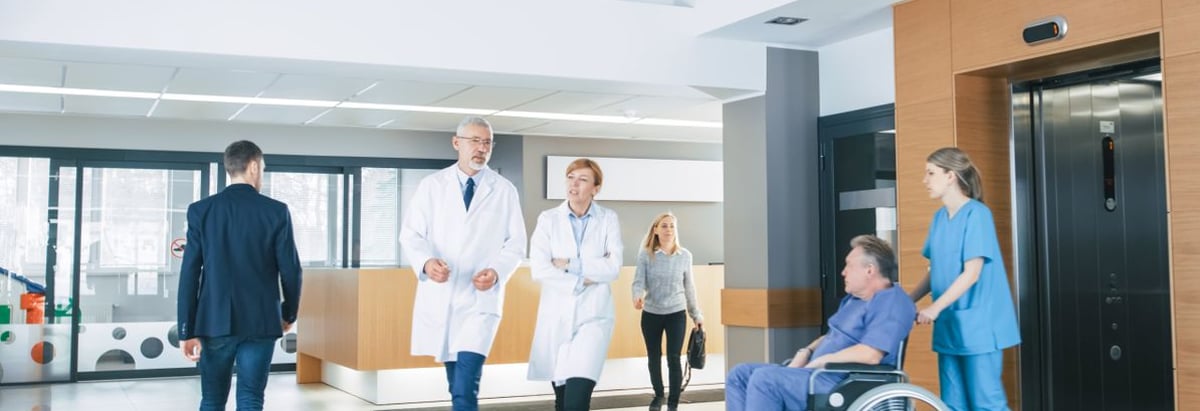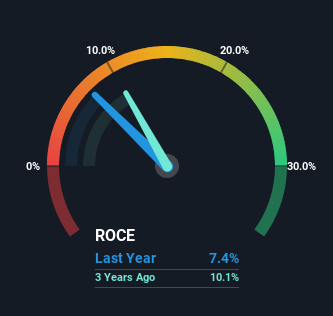- United States
- /
- Healthcare Services
- /
- NYSE:USPH
U.S. Physical Therapy (NYSE:USPH) Could Be Struggling To Allocate Capital

To find a multi-bagger stock, what are the underlying trends we should look for in a business? Firstly, we'd want to identify a growing return on capital employed (ROCE) and then alongside that, an ever-increasing base of capital employed. Put simply, these types of businesses are compounding machines, meaning they are continually reinvesting their earnings at ever-higher rates of return. Having said that, from a first glance at U.S. Physical Therapy (NYSE:USPH) we aren't jumping out of our chairs at how returns are trending, but let's have a deeper look.
What Is Return On Capital Employed (ROCE)?
For those that aren't sure what ROCE is, it measures the amount of pre-tax profits a company can generate from the capital employed in its business. Analysts use this formula to calculate it for U.S. Physical Therapy:
Return on Capital Employed = Earnings Before Interest and Tax (EBIT) ÷ (Total Assets - Current Liabilities)
0.074 = US$68m ÷ (US$1b - US$86m) (Based on the trailing twelve months to June 2023).
Therefore, U.S. Physical Therapy has an ROCE of 7.4%. Ultimately, that's a low return and it under-performs the Healthcare industry average of 9.7%.
View our latest analysis for U.S. Physical Therapy

In the above chart we have measured U.S. Physical Therapy's prior ROCE against its prior performance, but the future is arguably more important. If you'd like to see what analysts are forecasting going forward, you should check out our free report for U.S. Physical Therapy.
What The Trend Of ROCE Can Tell Us
On the surface, the trend of ROCE at U.S. Physical Therapy doesn't inspire confidence. Over the last five years, returns on capital have decreased to 7.4% from 14% five years ago. However, given capital employed and revenue have both increased it appears that the business is currently pursuing growth, at the consequence of short term returns. And if the increased capital generates additional returns, the business, and thus shareholders, will benefit in the long run.
What We Can Learn From U.S. Physical Therapy's ROCE
Even though returns on capital have fallen in the short term, we find it promising that revenue and capital employed have both increased for U.S. Physical Therapy. And there could be an opportunity here if other metrics look good too, because the stock has declined 15% in the last five years. As a result, we'd recommend researching this stock further to uncover what other fundamentals of the business can show us.
One more thing, we've spotted 4 warning signs facing U.S. Physical Therapy that you might find interesting.
If you want to search for solid companies with great earnings, check out this free list of companies with good balance sheets and impressive returns on equity.
New: AI Stock Screener & Alerts
Our new AI Stock Screener scans the market every day to uncover opportunities.
• Dividend Powerhouses (3%+ Yield)
• Undervalued Small Caps with Insider Buying
• High growth Tech and AI Companies
Or build your own from over 50 metrics.
Have feedback on this article? Concerned about the content? Get in touch with us directly. Alternatively, email editorial-team (at) simplywallst.com.
This article by Simply Wall St is general in nature. We provide commentary based on historical data and analyst forecasts only using an unbiased methodology and our articles are not intended to be financial advice. It does not constitute a recommendation to buy or sell any stock, and does not take account of your objectives, or your financial situation. We aim to bring you long-term focused analysis driven by fundamental data. Note that our analysis may not factor in the latest price-sensitive company announcements or qualitative material. Simply Wall St has no position in any stocks mentioned.
About NYSE:USPH
U.S. Physical Therapy
Operates and manages outpatient physical therapy clinics.
Excellent balance sheet with proven track record and pays a dividend.
Similar Companies
Market Insights
Community Narratives




